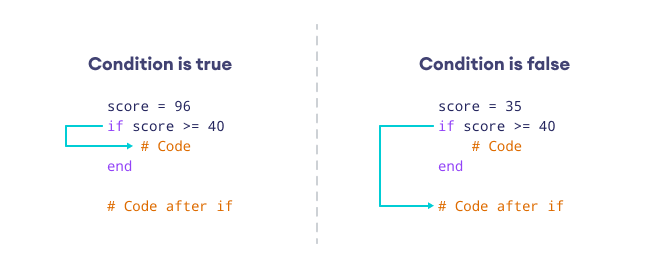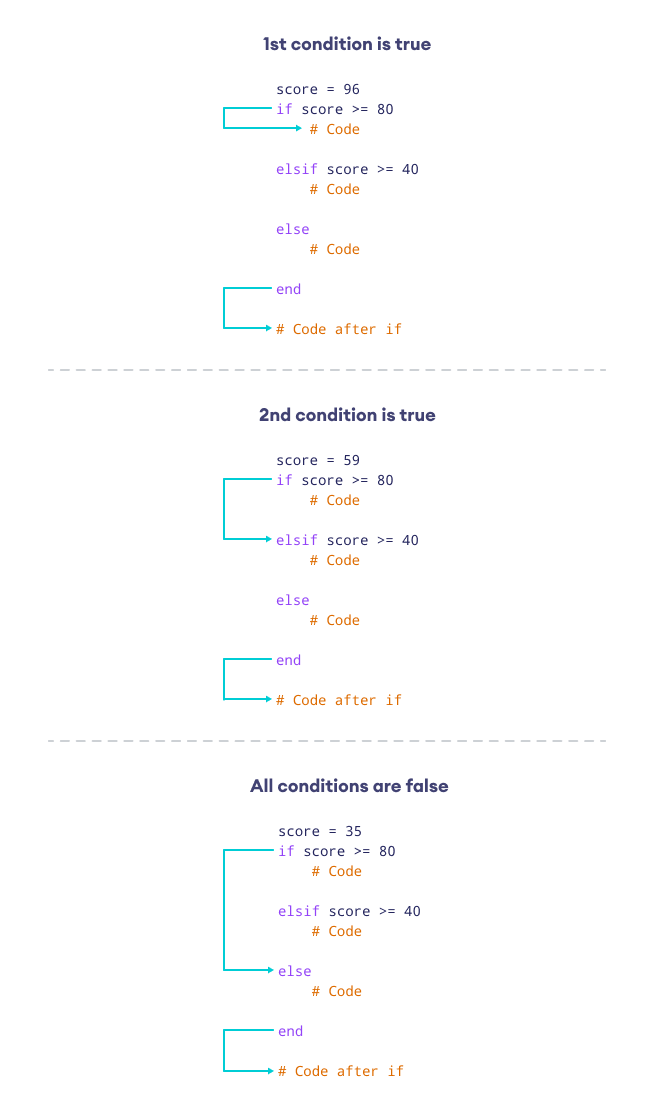Ruby 的 if...else 语句用于根据条件是 true 还是 false 来执行/跳过一段代码。
这是一个 if...else 语句的简单示例。你可以阅读本教程的其余部分以了解更多信息。
示例
num = 35
# Check if num is a positive number
if num > 0
puts "Positive number"
# Else, check if num is negative
elsif num < 0
puts "Negative number"
# If both conditions fail, num is 0
else
puts "Zero"
end
# Output: Positive number在上面的示例中,程序显示
- 如果 num 大于 0,则显示
正数。 - 如果 num 小于 0,则显示
负数。 - 如果没有任何条件匹配,则显示
零。
Ruby if 语句
我们使用 if 关键字根据某些特定条件执行代码。
if 语句的语法是
if condition
# Block of code
endif 关键字会检查 condition,并根据结果选择要执行的代码。如果 condition 的计算结果为
true- 将执行if块内的代码。false- 将跳过if块内的代码。
请注意语法中的 end 关键字;它用于指示 if 语句的结束。
请记住: 忘记使用 end 关键字会导致错误。

示例 1:Ruby if 语句
# Program to check if the student passed
score = 96
# Check if score is greater than or equal to 40
if score >= 40
# The body of the if statement
puts "You passed the examination."
end
puts "Program executed!"输出
You passed the examination. Program executed!
在上面的程序中,条件 score >= 40 的计算结果为 true,因为 score 为 96。因此,将执行 if 语句的主体。
如果分数低于 40(例如 35),则不会执行 if 语句的主体。
最后,由于 puts "Program executed!" 位于 if 语句的主体之外,因此无论 if 语句的结果如何,它都会被执行。
提示: 尝试将 score 的值更改为小于 40 的数字,看看会发生什么。
单行 if 语句
Ruby 也允许你使用单行 if 语句,语法如下
code if condition在这里,如果 condition 为 true,则会执行 code。例如:
score = 96
puts "You passed!" if score >= 40
# Output: You passed!在这里,代码 puts "You passed!" 被执行,因为条件 score >= 40 为 true。
Ruby else 语句
当前面 if 语句中的条件计算结果为 false 时,else 关键字会执行一段代码。
注意: else 语句应始终跟在 if 语句之后。换句话说,if 和 else 语句是单个条件结构的一部分。
if...else 语句的语法是
if condition
# Block of code to execute if the condition is true
else
# Block of code to execute if the condition is false
endif...else 语句会检查 condition,并以两种方式执行代码。如果 condition 为
true- 将执行if块内的代码。而else块内的代码将被跳过。false- 将跳过if块内的代码。相反,将执行else块内的代码。

示例 2:Ruby if…else 语句
# Program to check if the student passed or failed
score = 35
# Check if score is greater than or equal to 40
if score >= 40
# The body of the if statement
puts "You passed the examination."
else
# The body of the else statement
puts "You failed the examination."
end
puts "Program executed!"输出
You failed the examination. Program executed!
由于 score 为 35,因此 if 条件 (score >= 40) 的计算结果为 false。
因此,if 块内的代码被跳过。而 else 块内的代码被执行。
Ruby elsif 语句
如果初始 if 语句为 false,则使用 elsif 关键字来检查其他条件。
注意事项
- 在 Ruby 中,
elsif是 "else if" 的缩写。 if...elsif...else语句也称为 if...else 梯形图。
elsif 语句的语法是
# Check for first condition
if condition1
# if body
# Check for second condition
elsif condition2
# elsif body
# If no condition matches
else
# else body
end这里
- 首先,检查
if语句中的条件。如果条件计算为true,则执行if的主体,并跳过其余部分。 - 否则,将检查
elsif语句中的条件。如果为true,则执行其主体,其余部分将被跳过。 - 最后,如果没有条件匹配,则执行
else中的代码块。

示例 3:Ruby if...elsif 语句
score = 59
# Check if score is 80 or above
if score >= 80
puts "Excellent!"
# Else, check if score is 40 or above
elsif score >= 40
puts "Average"
# If both conditions fail, you fail the exam
else
puts "Failure!"
end
# Output: Average在这里,if 条件为 false,因为 score 为 59。但是,elsif 条件得到满足,因此程序打印 Average。
常见问题
我们可以根据需要多次使用 elsif 关键字。例如:
score = 85
# Condition for passing with second division
if score >= 40 && score < 60
puts "Second division"
# Condition for passing with first division
elsif score >= 60 && score < 80
puts "First division"
# Condition for passing with distinction
elsif score >= 80 && score <= 100
puts "Distinction"
# Condition for failing the exam
elsif score > 0 && score < 40
puts "You failed the examination."
# If all conditions fail, the score is invalid
else
puts "Invalid score!"
end
# Output: Distinction在上面的示例中,我们使用了三个 elsif 语句。
第二个 elsif 语句被执行,因为它的条件得到满足,而 if 和第一个 elsif 语句的条件未得到满足。
嵌套 if...else 语句
当我们使用嵌套在另一个 if...else 语句中的 if...else 语句时,我们就创建了一个嵌套 if...else 语句。例如,
score = 60
# Outer if...else statement
# Student passed if score 40 or above
# Otherwise, student failed
if score >= 40
# Inner if...else statement
# Distinction if score is 80 or above
if score >= 80
puts "Distinction"
else
puts "Passed"
end
else
puts "Failed"
end
# Output: Passed外部 if...else 语句
在上面的示例中,外部 if 条件使用 score >= 40 来检查学生是否通过或失败。如果计算结果为 false,则外部 else 语句将打印 "Failed"。
另一方面,如果 score >= 40 的计算结果为 true,则程序将进入内部 if...else 语句。
内部 if...else 语句
内部 if 条件使用 score >= 80 来检查学生是否以优异成绩通过。
如果 score >= 80 的计算结果为 true,则内部 if 语句将打印 "Distinction"。
否则,内部 else 语句将打印 "Passed"。
注意: 为保持代码的可读性并简化调试,请避免将多个 if...else 语句嵌套在一起。
更多关于 Ruby if...else 语句
被 Ruby 视为 true 的非布尔值称为 truthy,而 视为 false 的称为 falsy。
Ruby 将以下值视为 false
falsenil
其他所有值都被视为 true,包括:
- 0
- 空字符串 (
"") - 空数组 (
[])
要了解更多信息,请访问 Ruby 布尔值。
如果我们的操作非常简单,我们可以使用 三元运算符 ?: 代替 if...else 语句。例如:
score = 40
result = (score >= 40) ? "pass" : "fail"
puts result
# Output: pass当我们需要处理大量条件时,我们可以用 case 语句替换我们的 if…else 语句。例如:
score = "C"
# Using case statement
case score
# First condition
when "A"
puts "Excellent!"
# Second condition
when "B"
puts "Good!"
# Third condition
when "C"
puts "Average"
# Fourth condition
when "D"
puts "Bad"
else
puts "Fail"
end
# Output: Average如你所见,case 语句使我们的代码更具可读性和可维护性。
我们可以在 if 语句中使用逻辑运算符,如 && 和 || 来添加多个条件。例如,
age = 35
salary = 6000
# Combine two conditions using the "and" operator &&
if age >= 30 && salary >= 5000
puts "Eligible for premium membership."
else
puts "Not eligible for premium membership."
end
# Output: Eligible for premium membership.在这里,我们使用了逻辑运算符 && 在 if 语句中添加了两个条件。这两个条件是:
age >= 30salary >= 5000
由于 && 运算符,必须同时满足这两个条件,if 块才会被执行。
是的,你可以在 if...else 语句中使用用户输入。只需确保你已将输入转换为合适的类型。例如:
print "Enter your exam score: "
# Get user input using gets
user_input = gets.chomp
# Convert the input to integer
score = user_input.to_i
# Check if the user passed or failed
if score >= 40
puts "pass"
else
puts "fail"
end输出 1
Enter your exam score: 56 pass
输出 2
Enter your exam score: 25 fail
在这里,我们使用 gets.chomp 获取用户输入,该输入以字符串形式存储在 user_input 变量中。
因此,我们使用 to_i 方法将输入转换为整数,然后检查用户是否通过或失败。